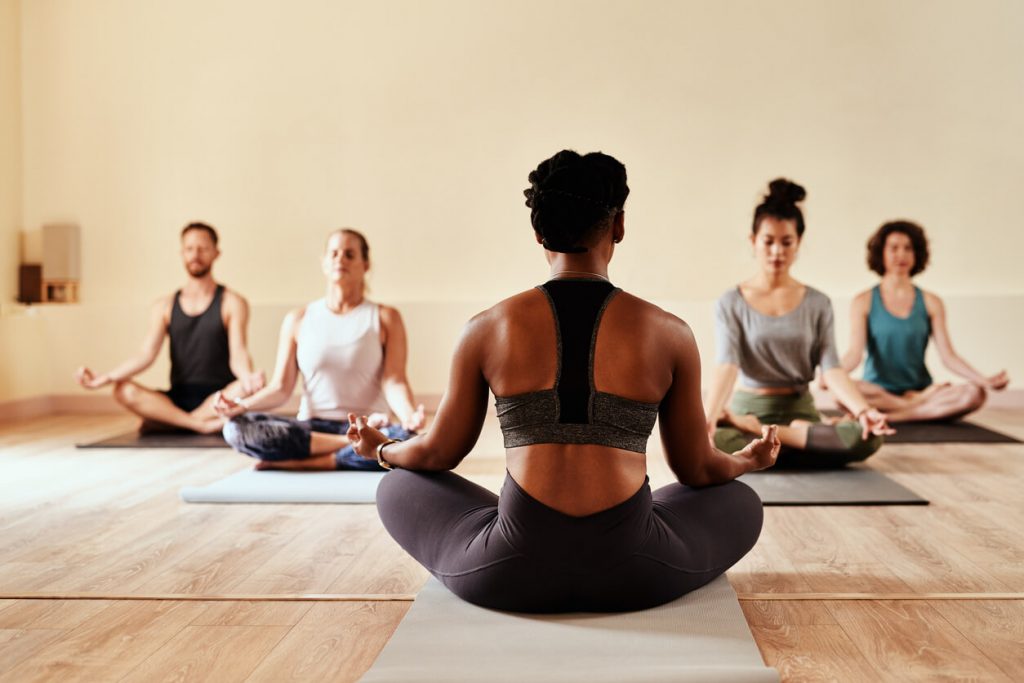If you’re a yoga instructor, you might be wondering how your salary compares to your competitors and whether your earnings are fair. You might be newly qualified, looking to set up your own yoga studio, and trying to work out how much you could make from your new profession.
Whatever your situation—if you’re reading this, we can only assume you’re interested in finding out more. So, what factors influence a yoga instructor salary?
We’ve done the research and spoken to industry professionals to find out just that.
Table of contents
1. Experience
2. Employment status
3. Location
4. Client base
5. Niche
6. Specialist yoga instructor insurance from Insure4Sport
1. How much does your experience influence yoga instructor salary?

The average yoga instructor salary differs depending on either the site you’re looking at or who you’re talking to. It’s also heavily impacted by the number of vacancies being compared on each site—meaning the salaries listed should be taken with a pinch of salt.
One thing you can be sure of, however, is that the more experience you have, the more you can expect to earn.
According to job site Jobted, which analyses all yoga instructor jobs posted on the platform, a yoga instructor with less than three years of experience can expect to earn around £10 per hour on average.
A ‘mid-career’ yoga instructor, or someone with between 4-9 years of experience, could see their hourly rate go up to around £24, while a ‘senior’ yogi with 10-20 years instructing under their belt can earn up to £36 an hour on average.
A yoga instructor with more than 20 years of experience could expect to earn anything between £40-£50 an hour. But of course, your annual earnings will ultimately depend on the number of hours you work.
Remember, though—these are just averages, and experience isn’t the only factor that influences a yoga instructor’s salary.
However, clearly, as with any profession, there’s scope to increase your earnings as you become more experienced at the job.
You’ll also have a lot more control over your salary if you run your own yoga studio and manage your own client load.
We asked professional barre yoga teacher Suse Knapman what new yoga instructors can do to gain valuable experience when starting out.
She said: “Gaining teaching experience as a newly qualified instructor can be hard, as a lot of the top-rated studios require you to have experience before you can start teaching there.
“So, what can you do? Firstly, go to the studios you would like to teach at and find out their exact requirements, take classes there, and get to know other teachers. They may need cover for classes, or might be able to offer advice.
“Secondly, teach classes to your friends and family, either as a group or one-to-one, so they can help promote your sessions – word of mouth is very powerful.
“Since Covid, teachers have realised the value of online teaching. This can be easy as you don’t need too much space or equipment, you’ve no overheads for renting space, and you spend less time travelling.
“New instructors might want to gain experience from in-person teaching, so you could look to rent cheap local spaces and set up regular classes.”
Related: 6 Creative Ways to Gain Experience as a New Yoga Teacher
2. Independent yoga instructor or studio employee: does it matter?

If you’re a newly qualified yoga instructor, one of the first challenges you’re likely to face is deciding whether to go self-employed or work for an existing organisation like a gym or leisure centre.
However, the beautiful thing about yoga—and, indeed, the health and wellbeing industry—is that there’s no ‘one size fits all’ approach to success and high earnings.
If you choose to work as an employee for an organisation, you’ll be paid a set wage for pre-determined, contracted hours at your agreed workplace. This could be a yoga studio, gym, or health club with yoga facilities, for example.
On the other hand, if you’re self-employed, you can obviously set your own working hours. In theory, this means your salary would be uncapped.
The pros and cons
Being an employee is often seen as the more obvious route to promotions and general career progression. As in any profession, joining a business in an entry-level position and learning from your seniors can help you climb the ladder quickly and receive a bigger salary in time.
Why then, you might ask, do so many yoga instructors in the UK choose to be self-employed?
Salary aside, there are several other factors you need to consider as a self-employed yoga instructor.
Location
Where will you operate from, and is it suitable? Put yourself in your client’s shoes and ask yourself whether your location is appealing. You’ll also need to consider your class pricing based on local demand.
Marketing
You’ll be starting from a clean slate regarding your marketing and branding, so it’s important to plan your tactics.
Whereas this work is largely done for you when you work for a large organisation, you’re on your own when you’re self-employed.
Your marketing needs to be on point to attract clients and, ultimately, money. Although good marketing is potentially costly to begin with, brands that invest in their marketing and PR often reap the rewards.
Suse Knapman: “Social media is another great way to gain credibility and attract new clients, so set up business profiles on Instagram and Facebook. Remember though that building your community and following can take time, so be consistent and think about what your clients want from you.”
Tax
Again, this is already taken care of when you’re an employee. But to go it alone, you’ll need to make sure you’re registered with HMRC, and you might even want to employ an accountant.
Insurance
If you’re self-employed, you’re responsible for securing your own specialist yoga instructor insurance to protect you, your studio, and any staff you employ. This insurance will protect you against injury and if any equipment is lost, damaged or stolen.

With all that considered, here’s what the experts say.
Phoebe Greenacre, a London-based yoga instructor, said: “I would definitely say working as a self-employed yoga instructor is better than working for a large organisation.
“I’m very much in the digital and online world, and that needs to be a part of any yoga instructor’s strategy so that they don’t have to spend 40+ hours a week teaching in person.
“It’s important for instructors to create digital products and courses online, so that they can spend more time on their craft and don’t get burnt out with in-person teaching.”
Related: Personal Training – Employed vs Self-Employed
3. How does location impact yoga instructor salary?

Research tells us that geographical location is another important factor in determining a yoga instructor’s salary.
Most people would probably automatically assume that wages in London are much higher than in other areas of the country.
However, while you can indeed earn a handsome salary as a yoga instructor in the capital, you needn’t necessarily move to London in order to make a decent wage.
As we mentioned earlier, the figures below* are based on averages determined by live job adverts—so, again, take them with a pinch of salt—but they’ll certainly give you a flavour.


Understanding how your yoga instructor salary can differ could be a major influence in where you choose to start your career.
*Average yoga instructor salaries and hourly rates (in amount order, according to Salary Expert) in the UK’s 10 most populated cities.
4. Does your client base size impact your salary as a yoga instructor?

This depends on whether you’re self-employed or an employee.
If you’re an employee, then the answer is no, probably not, as your salary is likely to be fixed already.
However, if you’re your own boss—then yes, of course, client base size will impact your salary, as the more paying customers you have, the more money you’ll have coming in.
One mistake new yoga instructors often make, though, is focusing too heavily on attracting new customers at the expense of retaining existing ones.
Client retention is just as important as onboarding. Once you have a paying client, keeping them should be a priority, as research would suggest you’re likely to attract more new customers through word of mouth.
Related: 7 Tips for Increasing Your Yoga Studio Income
5. Do you need a niche as a yoga instructor?

As a yoga instructor, your clients are all likely to be of different ages with varying experience levels. Not only is finding a niche an important general marketing tactic, but it can open the door to a greater salary potential, too.
If you’re offering something that nobody else is, more people will choose you—right?
The good thing about niches is that they can be flexible. So, if one day you feel you’ve outgrown your niche, or there’s no longer the same demand for it—you can change it or explore another niche. If your clients trust you, they’ll stay with you.
Having a niche as a yoga instructor is important because:
- Once you know your focus area, it becomes easier to promote your business, convey specific messaging and attract clients
- It allows you to be selective with your clients and say no to those who might not fit
- You can become an expert in your chosen niche, which boosts your future credibility
- You’ll get more referrals (in theory)
Adam Husler, a London-based yoga instructor who has hosted classes and workshops in more than 20 countries around the world, said: “More people than ever are practising yoga, meaning yoga teachers are getting paid more, right? Not quite.
“There’s also a rapidly increasing number of studios, and a huge amount of people each year are qualifying as teachers via their local studios or internationally. Though there are countless perks of teaching in studios, it’s not necessarily the most profitable way to make money teaching yoga.
“An income can be made from private classes, corporate events, in gyms, in hotels, online, organising your own public classes, or via carving a particular niche for yourself.
“A top tip for new teachers is to build your skill and client base before you rely on yoga teaching to be 100% of your income.”
Related: Why You Need A Niche For Your Yoga Or Wellness Business
What else impacts a yoga instructor salary?

Your yoga instructor salary is made up of several factors.
Aside from the points we’ve already discussed in this blog, you should also consider ways to expand your offering and diversify your services.
Covid, in particular, forced many businesses to pivot their model—in some cases, for good. Will you offer yoga sessions in person or just online? If the sessions are online-only, can you still charge the same? This is another challenge to consider.
In an ideal world, you also want your clients to look to you for knowledge, motivation, and inspiration, as well as your yoga sessions. But how can you convey this?
Perhaps you could think about becoming a freelance writer for lifestyle or yoga publications on the side, build a larger following via a yoga podcast, or create a wellbeing Instagram page?
All of this will boost your profile while potentially helping you to top up your salary.
Specialist yoga instructor insurance from Insure4Sport
If you’re a yoga instructor, regardless of your salary or how you operate, you should consider specialist yoga instructor insurance. If you own your own yoga studio, insurance is a legal requirement for you and your employees.
At Insure4Sport, we provide specialist yoga instructor insurance to protect you, your staff, and your studio.
This will protect you if a client claims against you for an injury they’ve suffered in one of your classes, and will compensate you if your yoga equipment is lost, damaged or stolen.
Find out more about how we can help and get an instant quote today.
Related
10 Marketing Strategies To Help You Grow Your Yoga Studio





Leave a Reply